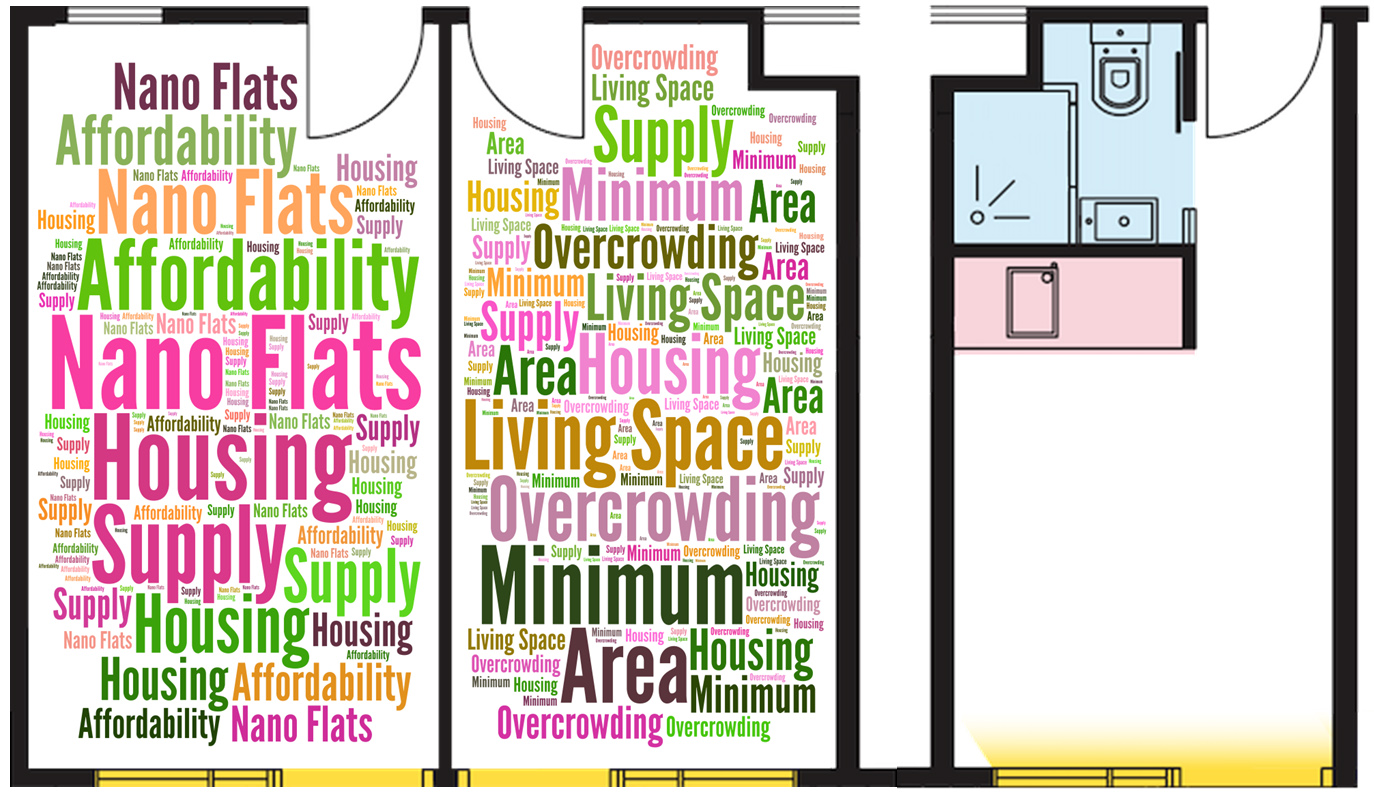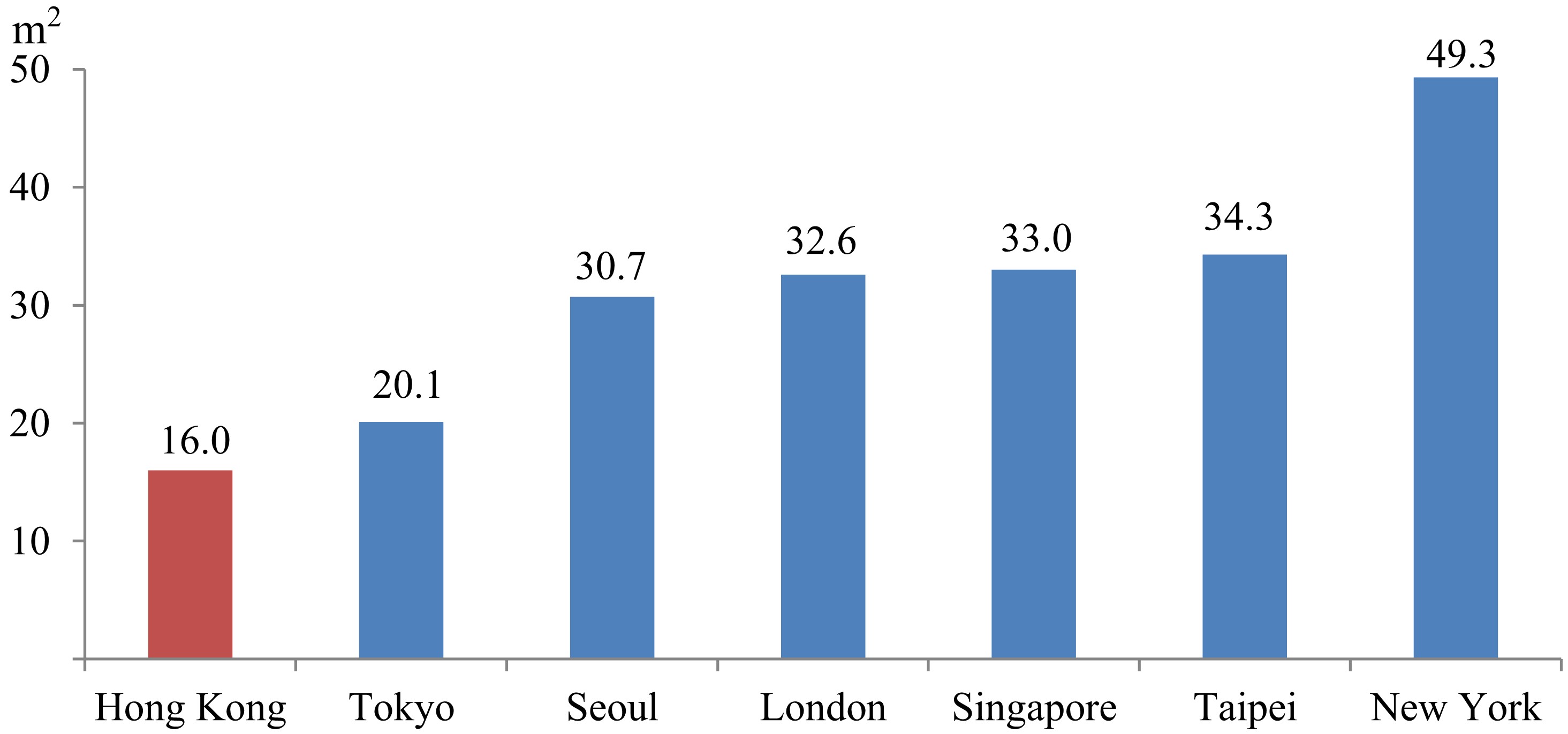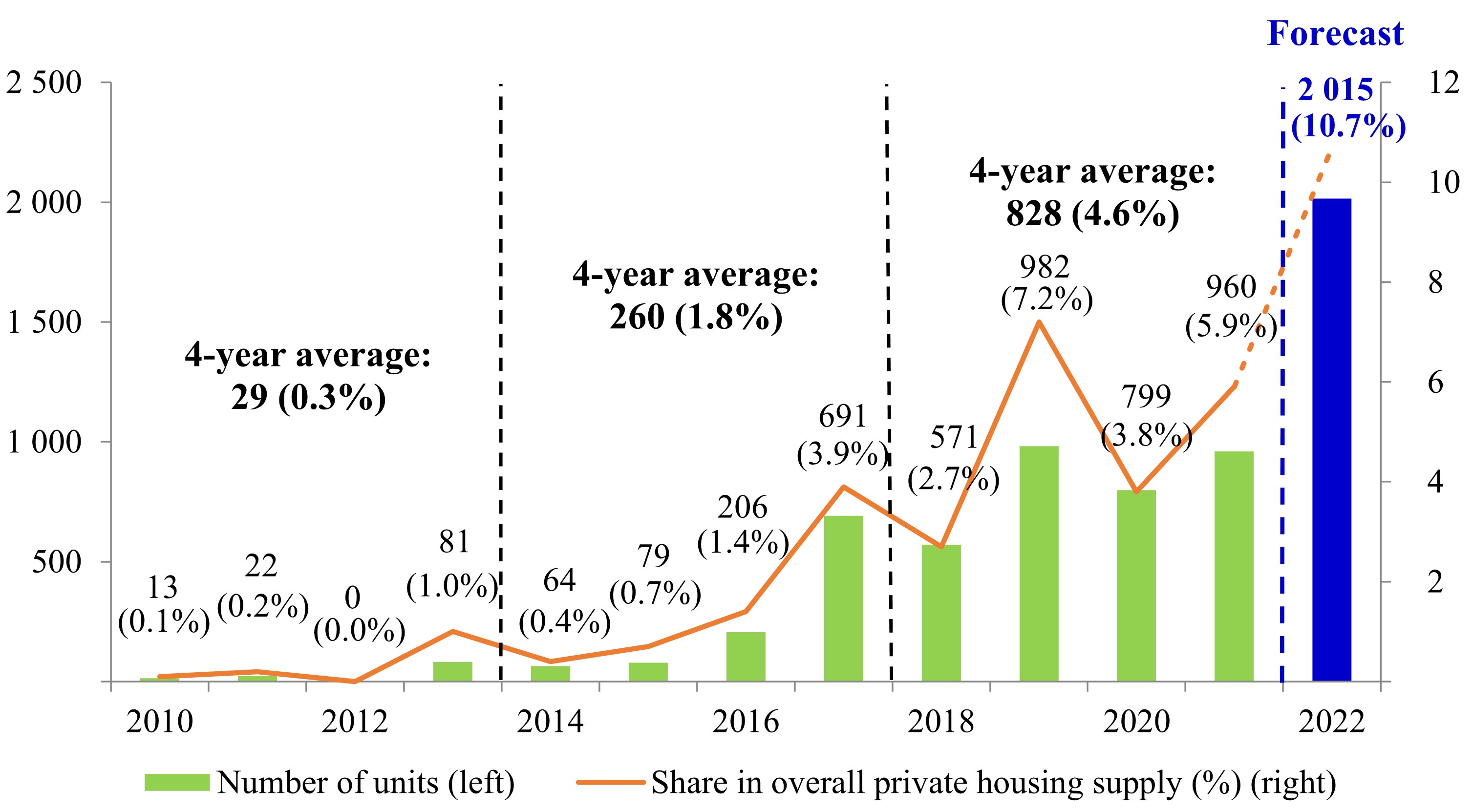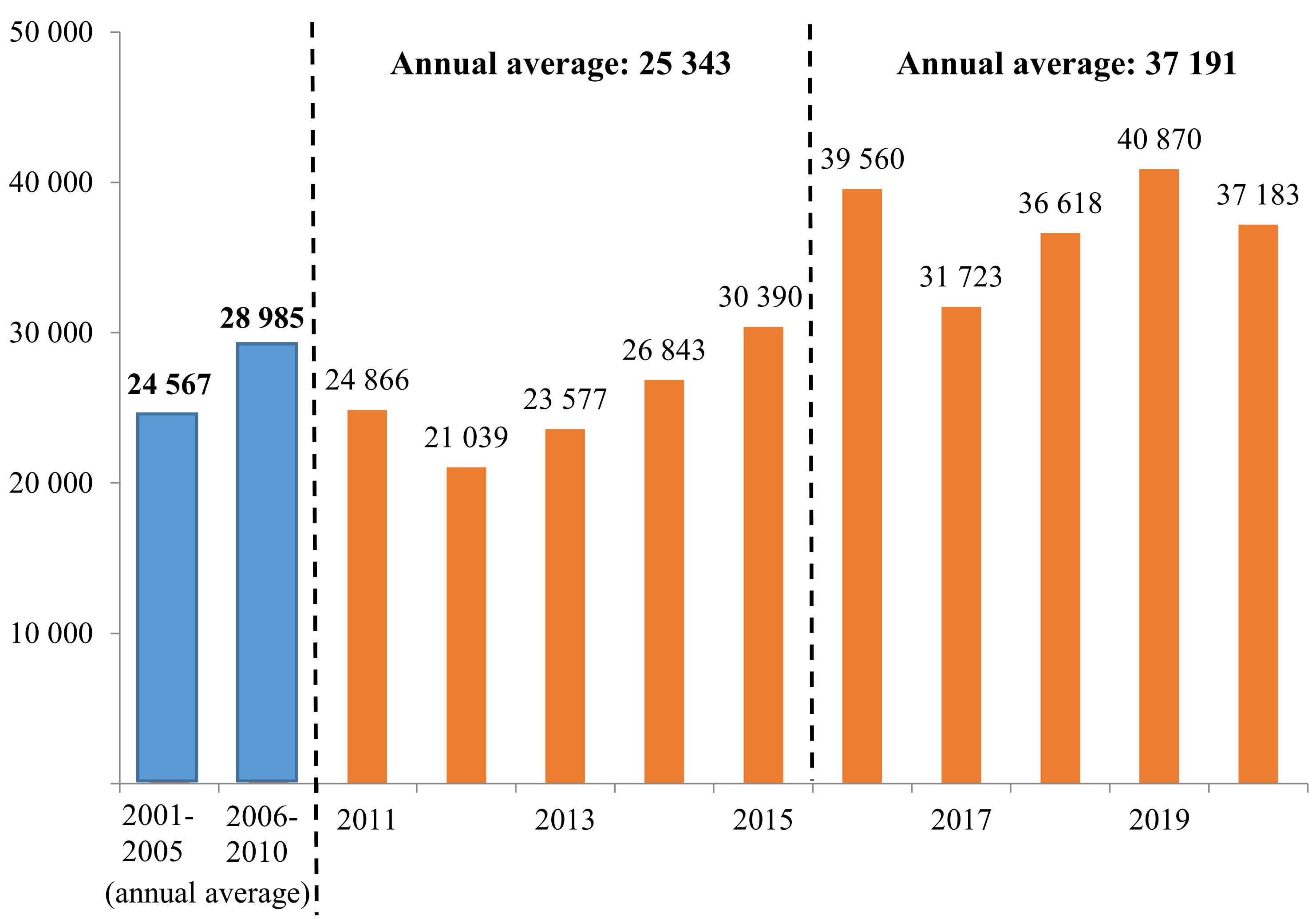Regulation on minimum home size in London
ISE09/2022

- With a median per capita living area of just 16 m2 in 2021 (and even more dire at 6.6 m2 for those residing in sub-divided flats), the living space in Hong Kong is low by global standard, way behind the 30 m2-35 m2 seen in advanced Asian cities like Seoul, Singapore and Taipei. As a crammed environment would dampen the quality of life of residents in many aspects, there is continued advocacy for government intervention. Public concerns have recently been raised over some 4 000 private residential flats with size less than 20 m2 (i.e. so-called "nano flats") newly completed during 2017 to 2021 and more in the pipeline.1Nano flats" are often understood as flats with a saleable area smaller than 20 m2. See Rating and Valuation Department (various years). While some commentators view this phenomenon as a market-based response to the prolonged problem of acute land shortage and worsening home purchase affordability in Hong Kong, others are concerned about crowded living space of nano flats and call for regulation of minimum size of new flats. Over the past five years, the subject of nano flats was discussed in the Legislative Council on at least 10 occasions.2During 2016 to 2021, the issue of nano flats was discussed six times in Council meetings, twice by the Panel on Financial Affairs, and once by the Panel on Development and at a Special Financial Committee meeting. Most recently, a motion debate on "Reforming the housing policy to resolve the housing problem" was held at the Council meeting during 14-15 July 2021. The motion urged the Government to, among other housing-related proposals, formulate a standard for the average living space per person. A Member further moved a motion amendment for setting a minimum flat size. See Legislative Council (2021).
- The Government has just promulgated a new requirement of minimum unit size of 26 m2 in its Land Sale Programme and new lease modification/land exchange applications as from 2022, in addition to emphasis placed on increasing land supply as a fundamental solution to enhance liveability. This move is welcomed by advocates, but some critics point out that it could have adverse consequences such as reducing overall supply of new flats in the short term, pricing out first-time flat buyers in a less ample financial position, and limiting dwelling choices.
- Globally, some advanced places (e.g. France and Netherlands) have put in place regulation on the minimum size of new flats.3Appolloni et al. (2021) and Sheridan et al. (2014). London is a more recent example, as its government made minimum home size mandatory through amending its planning system in 2011. Given that Hong Kong and London are both global financial centres facing chronic housing shortage, the policy experience of the latter should have much reference value. This issue of Essentials provides a brief account of respective policy developments in the two places.
Recent developments on flat size policy in Hong Kong
- Per capita living area: According to the 2016 Population By-Census, the per capita floor area of accommodation in Hong Kong was only 15 m2, with breakdown figures of 18 m2 for private housing residents and 11.5 m2 for public rental housing residents. While the figure slightly increased to 16 m2 in 2021, it still trails behind Tokyo (20.1 m2), which is also known for small living space, and lags far behind other advanced cities like Seoul (30.7 m2), London (32.6 m2), Singapore (33.0 m2), Taipei (34.3 m2) and New York (49.3 m2) (Figure 1).4The figures for Hong Kong and Singapore are medians while the others are mean averages. See Clay (2017), OECD (2018), Statistics of Tokyo (2019), Greater London Authority (2020), Statistics Singapore (2021) and 台北市主計處(2021). For the 226 000 local residents in sub-divided flats, the per capita living area was a minuscule 6.6 m2.
- Adverse implications: Congested accommodation without basic amenities can severely undermine the well-being of residents in ways such as (a) more frictions between family members or with other co-habitants; (b) poor physical health due to inadequate ventilation and daylighting; (c) worsened mental health amidst a lack of privacy and inactive social life; and (d) lower work and study efficiency.5Hong Kong Baptist University (2017), Sing et al. (2020) and Liber Research Community (本土研究社) (2020).
- Proliferation of nano flats: While it is difficult to increase living area for the entire population through simple regulation on flat sizes, social attention is drawn to a distinct pickup in construction of nano flats in recent years. Annual completions of nano flats stayed below 100 units during 2010 to 2015, before jumping to an annual average of 828 units during 2018 to 2021. They accounted for 4.6% of private housing supply in the latest four-year period (Figure 2). Looking ahead, it is projected that completions of nano flats will soar further to over 2 000 units in 2022, taking up nearly 11% of overall completions this year.6Figures for 2021 and 2022 are estimates. See JLL (2022) and Hong Kong Economic Journal (信報) (2022).
- Factors behind the new phenomenon: From an economic perspective, nano flats can be seen as a market-based response to the dilemma of buoyant housing demand facing land supply constraint. As a matter of fact, average size of new flats has been falling in the past decade in face of tighter budget constraints of home purchasers after rapid escalation of flat prices, especially first-time buyers. Smaller unit sizes (and hence smaller consideration value) could make it easier for buyers to obtain 90% loan-to-value mortgages with the help from the Mortgage Insurance Programme (between February 2013 and October 2019, only properties valued at HK$4 million or below were eligible for such mortgages).7The cap for 90% loan-to-value mortgages was raised to HK$8 million in October 2019 and further to HK$10 million recently in February 2022.On the demand side, as the average household size shrank steadily from 3.0 persons in 2008 to 2.7 in 2021, some smaller families (especially singletons) may find nano flats to be plausible options for meeting their housing needs at the right budget. Indeed, there is diversity in flat size aspirations in a pluralist society, as pointed out by the Government.
- No statutory instruments on minimum flat size for private housing developments in the past: At present, residential development density is largely regulated through domestic plot ratios laid down in statutory town plans and land leases.8In the 2010-2011 Budget, the Government announced to introduce requirements on the minimum number of flats and the range of size of such units in the land sale conditions for selected land sites, with a view to increasing the supply of small and medium-sized flats. No such land sites have been offered by the Government since late 2014. See Ming Pao (明報) (2021). However, the plot ratio can only govern the maximum gross floor area of a building as a whole, but not the size of individual flats.9Planning Department (2021b). In public housing or developments involving public bodies, this can be done through administrative measures (e.g. minimum flat sizes of 14.1 m2 for public rental housing and 27.9 m2 for projects of the Urban Renewal Authority ("URA")).In response to persistent calls from the local community to formulate "minimum living standards" for all accommodations, the Government often emphasized the need "to strike a reasonable balance" between overall housing supply and larger flat size. More recently in July 2021, it reiterated that setting such a standard alone could not enhance liveability due to the current acute housing shortage. Instead, increasing "land supply in a sustained manner" is a "more important and fundamental" solution.10Legislative Council (2021).
- New initiative as from 2022: In releasing the finalized "Hong Kong 2030+" in October 2021, the Government aimed to raise per capita living space to 20 m2-22 m2. This will be achieved through increasing land supply for one million new flats in both the private and public sectors in the next three decades, along with introduction of planning standards to increase flat sizes. For public housing under longer term planning (e.g. Kau Yi Chau artificial islands), flat sizes will be raised by 10%-20%.11Take 4-person public housing units for example, the size will be raised from about 37.2 m2 to about 44.6 m2 after a 20% home space enhancement. See Development Bureau (2021a).For private housing, the Government recently announced a new initiative on "minimum flat size" of 26 m2 in its 2022-2023 Land Sale Programme.12The Government explained that the limit of 26 m2 was set with reference to the minimum flat size of 23 m2 for the Starter Homes for Hong Kong Residents pilot project in Kwun Tong. The former is slightly larger because private housing is deemed "one rung up" the housing ladder. See GovHK (2021) and Development Bureau (發展局) (2021a-c). This requirement will apply to all land sales, railway property development projects and URA projects URA.13GovHK (2022). Meanwhile, all redevelopment projects in need of lease modification or land exchange will be subject to the same condition as from 25 February 2022.14In recent years, private redevelopment projects accounted for a major share of nano flat supply. For flats below 26 m2, the figure over the past four years was as high as 69%. See Liber Research Community (本土研究社) (2020), Our Hong Kong Foundation (團結香港基金) (2018) and Ming Pao (明報) (2022). (It is estimated that 13% of newly completed private flats over the past five were smaller than 26 m2, of which some 30% were smaller than 20 m2.)15South China Morning Post (2021).
- Issues of concerns: While the new initiative on minimum flat size requirement is welcomed by its advocates, others are sceptical about its effectiveness. First on the trade-off between flat size and private housing supply, the number of new flats could be compromised if there is no additional land available and no change in building intensity in the near term.16劉勵超(2022). Secondly on knock-on implications on flat prices amidst a reduced supply scenario, it would lower the purchase affordability for home buyers, especially first-time purchasers aspiring to buy an entry-level flat, unless developers would lower the per square foot prices of new flats concerned. Finally, some are concerned that the restriction would narrow the choices of both buyers and developers, thus drawing criticism that such practice is not entirely in line with the free market economy principle.
Regulation on minimum home size in London
- As a renowned global city, London is a magnet for talent from within and outside the United Kingdom ("UK"). Yet it is a challenge for the city to keep up with the consequential increase in housing demand, given its town planning framework is considered rather rigid and thus creates hurdles for new housing projects especially those to be located on green belts.
- Introduction of minimum home size in 2011: In 2004, the Greater London Authority ("GLA") announced the London Plan, setting out its strategy to increase housing supply for accommodation of population growth.17The London Plan is a statutory spatial development strategy made by the Greater London Authority, setting out the economic, environmental, housing, transport and social framework for development in the next 20-25 years. It is binding on local authorities responsible for making decisions on planning applications. See Greater London Authority (2021c). Yet it triggered public worries that increased home supply would be achieved at the expense of home sizes. GLA responded by commissioning a study on housing space standards in December 2005,18The study was conducted by a housing consultancy, covering topics such as trends in dwelling sizes, experiences of introducing minimum space standards elsewhere, views of stakeholders, assessment of possible implementation mechanisms, and a cost/benefit analysis. See HATC (2006). followed by public consultation on the proposed regulations in 2009.19The process of establishing minimum home sizes was briefly interrupted by a change of government in 2008 but was eventually completed as the new government still broadly supported the initiative. See Park (2017). A minimum home size standard ("the Standard") was eventually incorporated into GLA's updated London Plan released in 2011.20At that time, the UK did not have national dwelling space standards. The most significant national standard (with a minimum size of 29.7 m2) was adopted only for public housing in 1961, but even this was abolished by the then prime minister (Mrs Margaret Thatcher) in 1980 on the grounds of costs savings. However, following London's standards, the UK government in 2015 introduced a similar Nationally Described Space Standard, but it is optional for local governments to use. See HATC (2006) and Park (2017).
- Key features of new space requirements adopted: The Standard has stayed broadly unchanged since its inception, with the following salient features:
-
(a)Space size varying with the number of residents: Instead of a single size, the minimum space varies positively with the expected number of residents. For example, the minimum area of a studio or one-bedroom flat designed for one person is 37 m2, but it will increase to 50 m2 for a one-bedroom flat built intended for two persons (Figure 3).21The Standard in 2011 initially only covered homes of sizes up to four-bedroom and six persons, but was extended in 2016 and 2021 to cover six-bedroom, eight-person homes in line with the Nationally Described Space Standard introduced in 2015. See Greater London Authority (2011, 2016, 2021c). In the latest "London Plan 2021", there are even specifications on the size of bedroom (i.e. 7.5 m2 for singles and 11.5 m2 for doubles);22Greater London Authority (2021c).
Number of bedrooms (b) Number of bed spaces/persons (p) Minimum gross internal floor area (m2) 1-storey home 2-storey home 1b 1p 37 Not applicable 2p 50 58 2b 3p 61 70 4p 70 79 3b 4p 74 84 5p 86 93 6p 95 102 4b 5p 90 97 6p 99 106 7p 108 115 8p 117 124 Source: Greater London Authority (2021c). -
(b)Standard aimed at fulfilling basic needs: The Standard is positioned as a baseline, taking into account basic furniture and activities (e.g. cooking, dining and sleeping).23HATC (2006) and Greater London Authority (2021c). Given the minimum standard of 37 m2 was far smaller than the average size (46.9 m2) of one-bedroom flats which got planning permissions in 2009-2010,24Greater London Authority (2012). it appears to have limited binding effect for the majority of home building projects. Indeed, GLA concluded that minimum dwelling size requirements would not have significant effect on housing capacity, in response to feedback from developers under the relevant study conducted in 2006;25HATC (2006). and
-
(c)Implementation limited to local town planning system: As GLA is only a local government and does not have power to amend the nationwide Building Regulations, the Standard is applied only to new private and public developments as a condition when developers seek planning permissions in London. Developers must declare the number of bedrooms and expected number of occupants (as to be stated in sales and marketing materials) and comply with the Standard accordingly.26HATC (2006) and Greater London Authority (2021c).
-
- Concurrent supply-side initiatives: Apart from the adoption of minimum dwelling space requirements, GLA modified its town planning system to boost housing supply, such as by streamlining the permission process for redevelopment and allowing for higher-density developments. For instance, when old two-storey houses are converted into multi-storey apartment buildings, they can make way for many more new homes.27Greater London Authority (2020).Annual housing completions in London were in a steady uptrend, averaging at around 25 300 during 2011-2012 to 2015-2016. Annual completions jumped to over 30 000 from 2015-2016 onwards and reached a 60-year high of 40 870 units in 2019-2020 (Figure 4).
- Potential implications on dwelling choices: Regarding the concern over possible undersupply of smaller homes in London, anecdotal evidence suggests that some younger people aspiring to live independently may be forced to stay with their families in larger homes or share homes with unrelated persons.28Centre for Cities (2020). As an illustration, households with unrelated people sharing flats increased by 63% during 1996 to 2018 and accounted for one in seven of all households in London in 2018.29Greater London Authority (2021a). However, it is difficult to pinpoint the underlying reasons for this development, as other factors are also in play (e.g. housing cost affordability, emerging trend of co-living amidst development of sharing economy).
Concluding remarks
- The minimum size regulation in London does not appear to have significant adverse impacts on overall housing supply largely because developers are already offering larger unit sizes than the lowest requirement. More importantly, the concurrently introduced supply-side initiatives help boost overall housing supply which is fundamental to enhancing overall liveability and coping with the expected rising population in London.
Prepared by Germaine LAU
Research Office
Information Services Division
Legislative Council Secretariat
24 March 2022
Research Office
Information Services Division
Legislative Council Secretariat
24 March 2022
Endnotes:
- "Nano flats" are often understood as flats with a saleable area smaller than 20 m2. See Rating and Valuation Department (various years).
- During 2016 to 2021, the issue of nano flats was discussed six times in Council meetings, twice by the Panel on Financial Affairs, and once by the Panel on Development and at a Special Financial Committee meeting. Most recently, a motion debate on "Reforming the housing policy to resolve the housing problem" was held at the Council meeting during 14-15 July 2021. The motion urged the Government to, among other housing-related proposals, formulate a standard for the average living space per person. A Member further moved a motion amendment for setting a minimum flat size. See Legislative Council (2021).
- Appolloni et al. (2021) and Sheridan et al. (2014).
- The figures for Hong Kong and Singapore are medians while the others are mean averages. See Clay (2017), OECD (2018), Statistics of Tokyo (2019), Greater London Authority (2020), Statistics Singapore (2021) and 台北市主計處(2021).
- Hong Kong Baptist University (2017), Sing et al. (2020) and Liber Research Community (本土研究社) (2020).
- Figures for 2021 and 2022 are estimates. See JLL (2022) and Hong Kong Economic Journal (信報) (2022).
- The cap for 90% loan-to-value mortgages was raised to HK$8 million in October 2019 and further to HK$10 million recently in February 2022.
- In the 2010-2011 Budget, the Government announced to introduce requirements on the minimum number of flats and the range of size of such units in the land sale conditions for selected land sites, with a view to increasing the supply of small and medium-sized flats. No such land sites have been offered by the Government since late 2014. See Ming Pao (明報) (2021).
- Planning Department (2021b).
- Legislative Council (2021).
- Take 4-person public housing units for example, the size will be raised from about 37.2 m2 to about 44.6 m2 after a 20% home space enhancement. See Development Bureau (2021a).
- The Government explained that the limit of 26 m2 was set with reference to the minimum flat size of 23 m2 for the Starter Homes for Hong Kong Residents pilot project in Kwun Tong. The former is slightly larger because private housing is deemed "one rung up" the housing ladder. See GovHK (2021) and Development Bureau (發展局) (2021a-c).
- GovHK (2022).
- In recent years, private redevelopment projects accounted for a major share of nano flat supply. For flats below 26 m2, the figure over the past four years was as high as 69%. See Liber Research Community (本土研究社) (2020), Our Hong Kong Foundation (團結香港基金) (2018) and Ming Pao (明報) (2022).
- South China Morning Post (2021).
- 劉勵超(2022).
- The London Plan is a statutory spatial development strategy made by the Greater London Authority, setting out the economic, environmental, housing, transport and social framework for development in the next 20-25 years. It is binding on local authorities responsible for making decisions on planning applications. See Greater London Authority (2021c).
- The study was conducted by a housing consultancy, covering topics such as trends in dwelling sizes, experiences of introducing minimum space standards elsewhere, views of stakeholders, assessment of possible implementation mechanisms, and a cost/benefit analysis. See HATC (2006).
- The process of establishing minimum home sizes was briefly interrupted by a change of government in 2008 but was eventually completed as the new government still broadly supported the initiative. See Park (2017).
- At that time, the UK did not have national dwelling space standards. The most significant national standard (with a minimum size of 29.7 m2) was adopted only for public housing in 1961, but even this was abolished by the then prime minister (Mrs Margaret Thatcher) in 1980 on the grounds of costs savings. However, following London's standards, the UK government in 2015 introduced a similar Nationally Described Space Standard, but it is optional for local governments to use. See HATC (2006) and Park (2017).
- The Standard in 2011 initially only covered homes of sizes up to four-bedroom and six persons, but was extended in 2016 and 2021 to cover six-bedroom, eight-person homes in line with the Nationally Described Space Standard introduced in 2015. See Greater London Authority (2011, 2016, 2021c).
- Greater London Authority (2021c).
- HATC (2006) and Greater London Authority (2021c).
- Greater London Authority (2012).
- HATC (2006).
- HATC (2006) and Greater London Authority (2021c).
- Greater London Authority (2020).
- Centre for Cities (2020).
- Greater London Authority (2021a).
Essentials are compiled for Members and Committees of the Legislative Council. They are not legal or other professional advice and shall not be relied on as such. Essentials are subject to copyright owned by The Legislative Council Commission (The Commission). The Commission permits accurate reproduction of Essentials for non-commercial use in a manner not adversely affecting the Legislative Council. Please refer to the Disclaimer and Copyright Notice on the Legislative Council website at www.legco.gov.hk for details. The paper number of this issue of Essentials is ISE09/2022.


